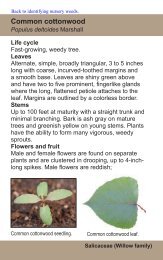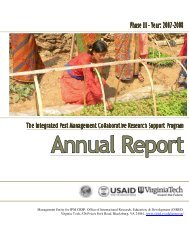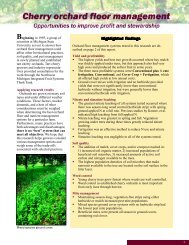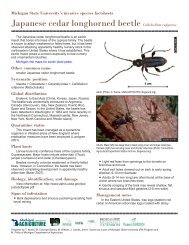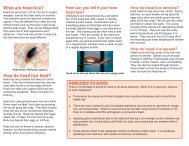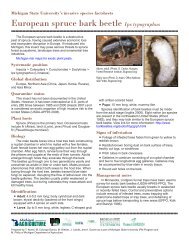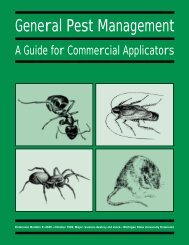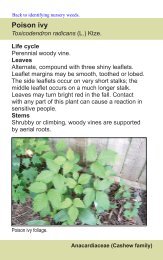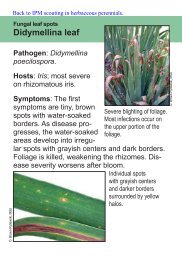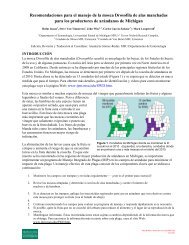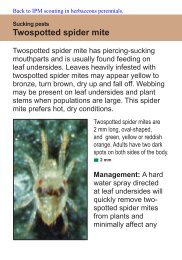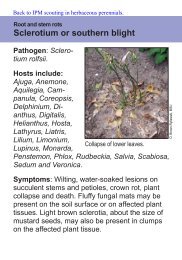Activities and Resources for Teaching K-6 - School Integrated Pest ...
Activities and Resources for Teaching K-6 - School Integrated Pest ...
Activities and Resources for Teaching K-6 - School Integrated Pest ...
Create successful ePaper yourself
Turn your PDF publications into a flip-book with our unique Google optimized e-Paper software.
#12<br />
Classroom Activity Grades 3-6<br />
All About Insects<br />
Overview<br />
In IPM we need to learn about the biology, habits<br />
<strong>and</strong> abilities of pests in order to manage them<br />
effectively. Students take notes <strong>and</strong> learn about the<br />
characteristics, capabilities <strong>and</strong> life cycles of insects.<br />
Objectives<br />
Students will:<br />
• learn characteristics of insects<br />
• learn parts of insects<br />
• learn about metamorphosis<br />
• observe live insects<br />
student worksheet, teacher key, teacher insect fact<br />
sheet, live insects<br />
1-2 hours<br />
science<br />
Materials<br />
Duration<br />
Subjects<br />
○ ○ ○ ○ ○ ○ ○ ○ ○ ○ ○ ○ ○ ○ ○ ○ ○ ○ ○ ○ ○ ○ ○ ○ ○ ○ ○ ○ ○ ○ ○ ○ ○ ○ ○ ○ ○ ○ ○ ○ ○ ○ ○ ○ ○ ○ ○ ○ ○ ○ ○ ○ ○ ○ ○ ○ ○ ○ ○ ○ ○<br />
Getting Ready<br />
Live insects bring this lesson to life. You may<br />
wish to rear insects in the classroom, or you may<br />
wish to collect some insects from outside to<br />
observe. For more in<strong>for</strong>mation on either option see<br />
the resource list on the following page.<br />
Review the teacher insect fact sheet to learn <strong>and</strong><br />
review characteristics <strong>and</strong> capabilities of insects. If<br />
you use live animals <strong>for</strong> this lesson, you may want to<br />
keep them covered or hidden until you are ready to<br />
introduce them to the students. Live animals are very<br />
interesting <strong>and</strong> can become a distraction when you<br />
want the students to concentrate on listening <strong>and</strong><br />
writing!<br />
Doing the Activity<br />
Step 1: Discussion. Tell the students that<br />
today we will learn more about insects <strong>and</strong> some<br />
insects that are pests. Ask: How does knowing the<br />
biology of pests help us manage them? Emphasize<br />
the importance of knowing how quickly pests<br />
reproduce, what they need to live <strong>and</strong> how they<br />
behave. When we know this, we can take away the<br />
things that they need to survive. We can trap them<br />
easier if we know the places they like to live <strong>and</strong><br />
travel. We can keep them out if we know how they<br />
come in <strong>and</strong> what they are capable of doing.<br />
Step 2: Taking Notes. Ask the students what<br />
they know about insects. Write the facts on the<br />
board. H<strong>and</strong> out the student worksheet. You may<br />
wish to copy the worksheet onto overhead film so<br />
that you can fill the worksheet in together with the<br />
class. Fill out the worksheet with the class by asking<br />
them the questions first <strong>and</strong> writing down the<br />
answers together. Explain the function of each body<br />
part. Add some fun insect facts from the teacher fact<br />
sheet.<br />
Step 3: Introduce Live Insects.<br />
(optional) Walkingsticks <strong>and</strong> Madagascar hissing<br />
cockroaches work well to demonstrate parts of an<br />
insect becuse they are large. If you do not have large<br />
Exploring Urban <strong>Integrated</strong> <strong>Pest</strong> Management 69<br />
Michigan State University <strong>Pest</strong>icide Education, 2001



